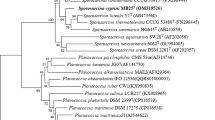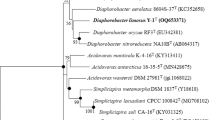Abstract
Investigation into the biodegradative capability of several actinomycetes led to the discovery of many strains possessing an ability to decolorize a variety of azo and triphenylmethane dyes. Of particular interest is an Amycolatopsis sp. isolate which displayed the ability to decolorize the azo dye amido black. Through the screening of a DNA library a 4.5 kbp fragment coding for the potential decolorization gene was identified. The sequencing of this gene fragment led to the prediction of seven open reading frames encoding a polyprenyl synthetase, cupin-2 conserved barrel domain, transcriptional regulator, membrane protein, DNA-damage inducible gene and two hypothetical proteins. A gene coding for a protein consisting of 312 amino acids with 77 % similarity to a conserved hypothetical protein in Amycolatopsis mediterranei was tentatively identified as the enzyme of interest. This is the first report of an amido black biodegrading gene identified in this species.




Similar content being viewed by others
References
Altschul SF, Gish W, Miller W, Myers EW, Lipman DJ (1990) Basic local alignment search tool. J Mol Biol 215:403–410
Bafana A, Chakrabarti T, Devi SS (2008) Azoreductase and dye detoxification activities of Bacillus velezensis strain AB. Appl Microbiol Biotechnol 77:1139–1144
Banat IM, Nigam P, Singh D, Marchant R (1996) Microbial decolorization of textile dye containing effluents: a review. Bioresour Technol 58:217–227
Bentley SD, Chater KF, Cerdeño-Tárraga AM, Challis GL, Thomson NR, James KD, Harris DE, Quail MA, Kieser H, Harper D, Bateman A, Brown S, Chandra G, Chen CW, Collins M, Cronin A, Fraser A, Goble A, Hidalgo J, Hornsby T, Howarth S, Huang CH, Kieser T, Larke L, Murphy L, Oliver K, O’Neil S, Rabbinowitsch E, Rajandream MA, Rutherford K, Rutter S, Seeger K, Saunders D, Sharp S, Squares R, Squares S, Taylor K, Warren T, Wietzorrek A, Woodward J, Barrell BG, Parkhill J, Hopwood DA (2002) Complete genome sequence of the model actinomycete Streptomyces coelicolor A3(2). Nature 417:141–147
Blumel S, Knackmuss H-J, Stolz A (2002) Molecular cloning and characterization of the gene coding for the aerobic azoreductase from Xenophilus azovorans KF46F. Appl Microbiol Biotechnol 68:3948–3955
Chen H, Hopper SL, Cerniglia CE (2005) Biochemical and molecular characterization of an azoreductase from Staphylococcus aureus, a tetrameric NADPH-dependent flavoprotein. Microbiology 151:1433–1441
Chou DK, Krishnamurthy R, Randolph TW, Carpenter JF, Manning MC (2005) Effects of tween 20® and tween 80® on the stability of albutropin during agitation. J Pharm Sci 94:1368–1381
Chung J, Chen T, Missiakas D (2000) Transfer of electrons across the cytoplasmic membrane by DsbD, a membrane protein involved in thiol–disulfide exchange and protein folding in the bacterial periplasm. Mol Microbiol 35:1099–1109
Dabbs ER, Gowan B, Anderson SJ (1990) Nocardioform arsenic resistance plasmids and construction of Rhodococcus cloning vectors. Plasmid 23:242–247
Dereeper A, Guignon V, Blanc G, Audic S, Buffet S, Chevenet F, Dufayard J-F, Guindon S, Lefort V, Lescot M, Claverie J-M, Gascuel O (2008) Phylogeny. fr: robust phylogenetic analysis for the non-specialist. Nucleic Acids Res 36:W465–W469
Doble M, Kumar A (2005) Biotreatment of industrial effluents. Elsevier Butterworth-Heinemann, Oxford
Forgacs E, Cserhati T, Oros G (2004) Removal of synthetic dyes from wastewaters: a review. Environ Int 30:953–971
Goszczynski S, Paszczynski A, Pasti-Grigsby MB, Crawford RL, Crawford DL (1994) New pathway for degradation of sulfonated azo dyes by microbial peroxidases of Phanerochaete chrysosporium and Streptomyces chromofuscus. J Bacteriol 176:1339–1347
Grekova-Vasileva M, Popov I, Vassilev D, Topalova Y (2009) Isolation and characterisation of microbial strain AZO29 capable of azo dye decolourization. XI anniversary scientific conference special edition on-line
Gurung TD, Sherpa C, Agrawal VP, Lekhak B (2009) Isolation and characterization of antibacterial actinomycetes from soil samples of Kalapatthar, Mount Everest region. Nepal J Sci Technol 10:173–182
Harazono K, Nakamura K (2005) Decolorization of mixtures of different reactive textile dyes by the white-rot basidiomycete Phanerochaete sordida and inhibitory effect of polyvinyl alcohol. Chemosphere 59:63–68
Hill RT, Illing N, Kirby R, Woods DR (1989) Development of pLR591, a Streptomyces–Escherichia coli positive selection shuttle vector. FEMS Microbiol Lett 57:223–226
Hu TL (1994) Decolourization of reactive azo dyes by transformation with Pseudomonas luteola. Bioresour Technol 49:47–51
Jendrossek D, Tomasi G, Kroppenstedt RM (1997) Bacterial degradation of natural rubber: a privilege of actinomycetes? FEMS Microbiol Lett 150:179–188
Katzen F, Deshmukh M, Daldal F, Beckwith J (2002) Evolutionary domain fusion expanded the substrate specificity of the transmembrane electron transporter DsbD. EMBO J 21:3960–3969
Kieser T, Bibb MJ, Buttner MJ, Chater KF, Hopwood DA (2000) Practical Streptomyces genetics. John Innes Foundation, United Kingdom
Kokol V, Doliska A, Eichlerova I, Baldrian P, Nerud F (2007) Decolorization of textile dyes by whole cultures of Ischnoderma resinosum and by purified laccase and Mn-peroxidase. Enzym Microb Technol 40:1673–1677
Kudlich M, Keck A, Klein J, Stolz A (1997) Localization of the enzyme system involved in anaerobic reduction of azo dyes by Sphingomonas sp. strain BN6 and effect of artificial redox mediators on the rate of azo dye reduction. Appl Microbiol Biotechnol 63:3691–3694
Maniatis T, Fritsch EF, Sambrook J (1982) Molecular cloning: a laboratory manual. Cold Spring Harbour, New York
Missiakas D, Schwager F, Raina S (1995) Identification and characterization of a new disulphide isomerase-like protein (DsbD) in Escherichia coli. EMBO J 14:3415–3424
Molina-Guijarro JM, Perez J, Munoz-Dorado J, Guillen F, Moya R, Hernandez M, Arias ME (2009) Detoxification of azo dyes by a novel pH-versatile, salt-resistant laccase from Streptomyces ipomoea. Int Microbiol 12:13–21
Mugerfeld I, Law BA, Wickham SG, Thompson DK (2009) A putative azoreductase gene is involved in the Shewanella oneidensis response to heavy metal stress. Appl Microbiol Biotechnol 82:1131–1141
Nachiyar CV, Rajkumar GS (2005) Degradation of a tannery and textile dye, Navitan fast blue S5R by Pseudomonas aeruginosa. World J Microbiol Biotechnol 19:609–614
Pospiech A, Neumann B (1995) A versatile quick-prep of genomic DNA from Gram-positive bacteria. Trends Genet 11:217–218
Reese ET, Maguire A (1969) Surfactants as stimulants of enzyme production by microorganisms. Appl Microbiol 17:242–245
Robinson T, McMullan G, Marchant R, Nigam P (2001) Remediation of dyes in textile effluent: a critical review on current treatment technologies with a proposed alternative. Bioresour Technol 77:247–255
Roxon JJ, Ryan AJ, Wright SE (1967) Enzymatic reduction of tartrazine by Proteus vulgaris from rats. Food Cosmet Toxicol 5:645–656
Saitou N, Nei M (1987) The neighbor-joining method: a new method for reconstructing phylogenetic trees. Mol Biol Evol 4:406–425
Stolz A (2001) Basic and applied aspects in the microbial degradation of azo dyes. Appl Microbiol Biotechnol 56:69–80
Suzuki Y, Yoda T, Ruhul A, Sugiura W (2001) Molecular cloning and characterization of the gene coding for azoreductase from Bacillus sp. OY1-2 isolated from soil. J Biol Chem 276:9059–9065
Swamy J, Ramsay JA (1999) The evaluation of white rot fungi in the decoloration of textile dyes. Enzym Microb Technol 24:130–137
Vijaykumar MH, Vaishampayan PA, Shouche YS, Karegouda TB (2007) Decolourization of naphthalene-containing sulfonated azo dyes by Kerstersia sp. strain VKY1. Enzym Microb Technol 40:204–211
Walsh C (2003) Antibiotics: action, origins, resistance. ASM Press, USA
Yang Q, Yang M, Pritsch K, Yediler A, Hagn A, Schloter M, Kettrup A (2003) Decolorization of synthetic dyes and production of manganese-dependent peroxidase by new fungal isolates. Biotechnol Lett 25:709–713
Acknowledgments
We graciously acknowledge Sir D. Hopwood for kind provision of the Practical Streptomyces Genetics manual, the National research foundation for financial support and John Innes Institute for providing S. lividans TK23 and pIJ702.
Conflict of interest
The authors declare that they have no conflict of interest.
Author information
Authors and Affiliations
Corresponding author
Electronic supplementary material
Below is the link to the electronic supplementary material.
Rights and permissions
About this article
Cite this article
Chengalroyen, M.D., Dabbs, E.R. Identification of a gene responsible for amido black decolorization isolated from Amycolatopsis orientalis . World J Microbiol Biotechnol 29, 625–633 (2013). https://doi.org/10.1007/s11274-012-1218-8
Received:
Accepted:
Published:
Issue Date:
DOI: https://doi.org/10.1007/s11274-012-1218-8




